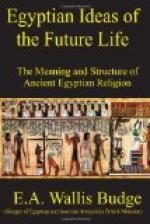But though we know nothing about the period of the origin in Egypt of the belief in the existence of an almighty God who was One, the inscriptions show us that this Being was called by a name which was something like Neter, [Footnote: There is no e in Egyptian, and this vowel is added merely to make the word pronounceable.] the picture sign for which was an axe-head, made probably of stone, let into a long wooden handle. The coloured picture character shews that the axe-head was fastened into the handle by thongs of leather or string, and judging by the general look of the object it must have been a formidable weapon in strong, skilled hands. A theory has recently been put forward to the effect that the picture character represents a stick with a bit of coloured rag tied to the, but it will hardly commend itself to any archaeologist. The lines which cross the side of the axe-head represent string or strips of leather, and indicate that it was made of stone which, being brittle, was liable to crack; the picture characters which delineate the object in the latter dynasties shew that metal took the place of the stone axe-head, and being tough the new substance needed no support. The mightiest man in the prehistoric days was he who had the best weapon, and knew how to wield it with the greatest effect; when the prehistoric hero of many fights and victories passed to his rest, his own or a similar weapon was buried with him to enable him to wage war successfully in the next world. The mightiest man had the largest axe, and the axe thus became the symbol of the mightiest man. As he, by reason of the oft-told narrative of his doughty deeds at the prehistoric camp fire at eventide, in course of time passed from the rank of a hero to that of a god, the axe likewise passed from being the symbol of a hero to that of a god. Far away back in the early dawn of civilization in Egypt, the object which I identify as an axe may have had some other signification, but if it had, it was lost long before the period of the rule of the dynasties in that country.
Passing now to the consideration of the meaning of the name for God, neter, we find that great diversity of opinion exists among Egyptologists on the subject. Some, taking the view that the equivalent of the word exists in Coptic, under the form of Nuti, and because Coptic is an ancient Egyptian dialect, have sought to deduce its meaning by seeking in that language for the root from which the word may be derived. But all such attempts have had no good result, because the word Nuti stands by itself, and instead of being derived from a Coptic root is itself the equivalent of the Egyptian neter, [Footnote: The letter r has dropped out in Coptic through phonetic decay.] and was taken over by the translators of the Holy Scriptures from that language to express the words “God” and “Lord.” The Coptic root nomti cannot in any way be connected with nuti, and the attempt to prove




